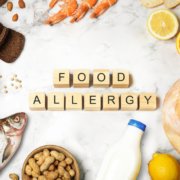Understanding Food Allergies
Food allergies are getting more attention in recent years – which is a good thing! Around 32 million Americans, including 5.6 million children, are living with a potentially life-threatening food allergy. The more we know about allergies, the better!
Food Allergy vs Food Sensitivity
First things first; food allergies and food sensitivities or intolerances aren’t the same thing. Food allergies are a serious medical condition where your body’s immune system reacts to a specific food protein. It can look like getting a rash or hives, swelling, dizziness, itching, and even anaphylaxis (a serious reaction that can affect breathing and blood pressure read more here).
If someone thinks they or a family member may have a food allergy, a medical provider should be the one to test and diagnose the allergy.
Food sensitivities or intolerances do not involve the immune system. Things like lactose intolerance, gluten sensitivity, and others are in the digestive system. They can cause serious discomfort like bloating, constipation, cramping, and nausea, but they can’t be fatal. Read more about food sensitivities.
Most Common Food Allergies
People can be allergic to many different kinds of food. Common food allergies are:
- Peanuts – One of the most common food allergies in children and adults, peanuts – a legume (different from a tree nut) – is usually a lifelong allergy.
- Milk and Dairy Products – Cow’s milk is the most common allergy in infants and young children, though most outgrow it. It is also one of the most common adult food allergies too.
- Eggs – A common food allergy for babies and children, many will outgrow it. Some adults remain allergic, and it can be to egg whites, or egg yolks since they contain different proteins.
- Shellfish – Allergies to this type of seafood, including shrimp, prawns, lobster, and crayfish are typically lifelong, though most people don’t experience a reaction until they are an adult.
- Soy – Most common in infants and young children, most outgrow a soy allergy. Soy is a legume like peanuts but being allergic to one doesn’t mean someone will be allergic to the other.
- Wheat – This allergy affects children the most, but many outgrow it by age 10. This is not the same a celiac disease, wheat allergies are to the proteins found in wheat, not gluten.
- Tree Nuts – Not the same as peanuts, tree nuts include almonds, cashews, walnuts, and more. An allergy to these nuts also includes things like nut butters and oils. Being allergic to one type of tree nut increases the risk of becoming allergic to other tree nuts.
What Next?
If you or a loved one is diagnosed with a food allergy, try not to feel overwhelmed. While it does mean you need to change what you eat, there are many resources and people and groups to support you, including NOAH’s Nutrition Services team.
Make sure you have a proper diagnosis with a medical provider. Discuss with them what the diagnosis means. Will the child outgrow it? What medications should you have? What does a severe reaction look like?
Finally, the most important thing to know is that the best way to prevent an allergic reaction to food is to avoid that food. That is what most doctors recommend along with having an epi-pen on-and always to treat any reaction to food allergies. Even a small amount can cause a reaction, but here are some tips.
There is promising news about a new intensive treatment called “food allergen desensitization” which is available and can resolve the allergy in some cases – though definitely not all cases. If you are interested in learning more about this treatment, ask your medical provider if this is right for you.
To get you started on figuring out your food allergies and staying safe, check out our recipes with different ingredient options.





